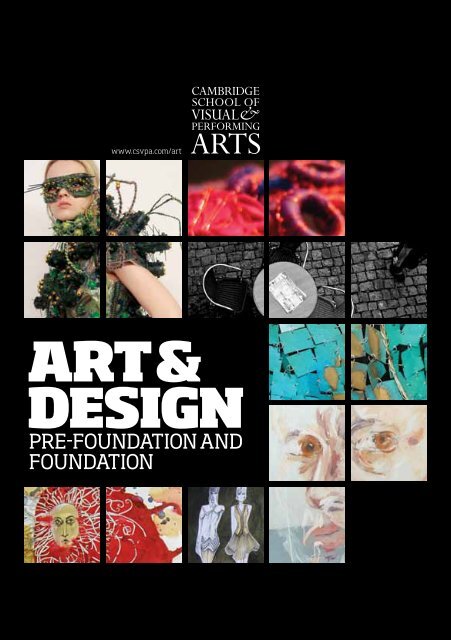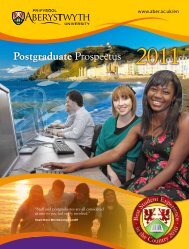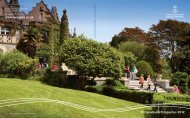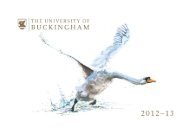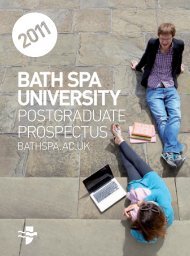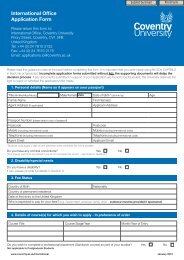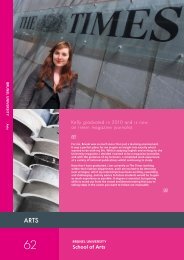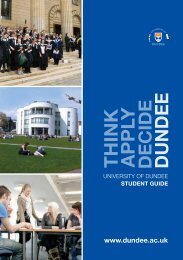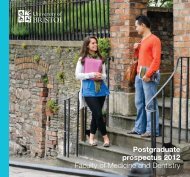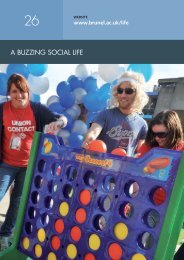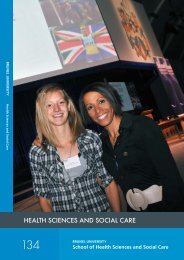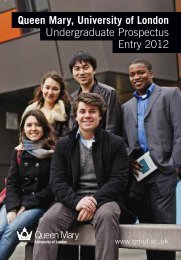ART & DESIGN
ART & DESIGN
ART & DESIGN
You also want an ePaper? Increase the reach of your titles
YUMPU automatically turns print PDFs into web optimized ePapers that Google loves.
www.csvpa.com/art<br />
<strong>ART</strong> &<br />
<strong>DESIGN</strong><br />
pre-foundation and<br />
foundation
<strong>ART</strong> &<br />
<strong>DESIGN</strong><br />
PRE-FOUNDATION<br />
Available in Cambridge and London<br />
www.csvpa.com/prefoundation<br />
The Pre-Foundation course will allow you to build your portfolio<br />
of work in order to progress onto the Foundation programme. On<br />
completion you are guaranteed progression onto the University<br />
of the Arts London Awarding Body Foundation Diploma in<br />
Art & Design at Cambridge School of Visual & Performing Arts.<br />
“<br />
The student environment at CSVPA and<br />
in Cambridge is really good. CSVPA is very<br />
friendly; students and teachers are very<br />
close, which makes it easy to discuss<br />
things. You do not feel uncomfortable to<br />
talk to them. They help and support me in<br />
everything. Once I have finished the Pre-<br />
Foundation I want to go onto the Foundation<br />
programme at CSVPA. I do not want to<br />
go anywhere else, I like the way I<br />
am taught here. The location is ideal,<br />
being right in the centre of Cambridge.<br />
”<br />
Yai Chipsomsong · Thailand<br />
Pre-Foundation
ONE & TWO-TERM OPTION*<br />
If you have completed high school and are an international student<br />
needing to develop your art and design skills further then you should<br />
join either the one or two-term Pre-Foundation course.<br />
THREE TERMS<br />
If you have not completed high school and you know you want to<br />
pursue a career in art and design but need an academic qualification<br />
for entry onto the Foundation diploma, then the three-term Pre-<br />
Foundation course is the route for you. You will leave the programme<br />
with an AS level in Photography or Art Video, an AS level in Art, Craft<br />
& Design, plus the option to take an A level in your own language.<br />
Key Facts<br />
One Term Two Terms Three Terms<br />
Age 17 years+ 17 years + 16 years +<br />
Educational<br />
Level<br />
Completed 11<br />
years’ schooling<br />
Completed 11<br />
years’ schooling<br />
Completed 11<br />
years’ schooling<br />
English Level IELTS 4.5+ IELTS 4.5+ IELTS 5.0+<br />
Portfolio Limited required Limited required Limited required<br />
Start April January September<br />
Course Length 1 term 2 terms 3 terms<br />
Taught<br />
Contact Time<br />
Up to 23 hours<br />
per week<br />
Up to 23 hours<br />
per week<br />
Up to 23 hours<br />
per week<br />
English<br />
Language**<br />
Up to 5 hours per<br />
week if required<br />
Up to 5 hours per<br />
week if required<br />
Up to 5 hours per<br />
week if required<br />
Progression Foundation Foundation Foundation<br />
* not available in London<br />
** additional hours on top of taught contact time
1 or 2<br />
Terms<br />
3<br />
Terms<br />
COMPULSORY SUBJECTS<br />
Life Drawing • •<br />
Visual Studies • •<br />
Academic<br />
English<br />
AS level<br />
Photography<br />
or Art Video<br />
Art, Craft<br />
& Design<br />
A Level<br />
• •<br />
•<br />
•<br />
Teaching &<br />
Assessment<br />
3 Terms<br />
AQA assessment criteria<br />
are used for the AS level<br />
Art & Design subjects<br />
(in the form of assessed<br />
coursework/exam project).<br />
Continual project<br />
assessment for Life Drawing<br />
and Visual Studies.<br />
1 or 2 Terms<br />
Continual project assessment,<br />
the grades of which equate<br />
to the final grade.<br />
sample timetable<br />
Mon<br />
Tues<br />
Wed<br />
Thurs<br />
09.00 10.00 11.00–13.00 14.00–17.00<br />
English<br />
language<br />
English<br />
language<br />
English<br />
language<br />
English<br />
language<br />
Drawing<br />
skills<br />
Drawing<br />
skills<br />
Fine art<br />
Photography Photography Textiles<br />
Photography Photography Fine art<br />
Mandatory<br />
studio practice<br />
Life drawing<br />
Mandatory<br />
studio practice<br />
Own Language<br />
Disciplines * **<br />
•<br />
Fri<br />
English<br />
language<br />
Textiles Textiles Mandatory<br />
studio practice<br />
Graphics • •<br />
Textiles • •<br />
Fine Art • •<br />
3D • •<br />
Photography<br />
or Art Video<br />
•<br />
* compulsory<br />
** 4 disciplines over 8weeks, then reduce to 2<br />
WHAT SHOULD I INCLUDE<br />
IN MY PORTFOLIO<br />
Your portfolio is the chance to show us<br />
your skills and passion, and as a guide<br />
we would like to see the following:<br />
• taught and personal work<br />
• drawing skills (from direct<br />
observation and reference)<br />
• personal ideas and areas of interest<br />
(if fashion is your passion, show us)<br />
• experimentation with a range of<br />
different media and materials<br />
• a breadth of interest in and<br />
exploration of a range of art<br />
and design disciplines<br />
• research and ideas in<br />
sketchbooks or notebooks
“<br />
Cambridge School of Visual &<br />
Performing Arts was recommended<br />
to me as one of the best schools<br />
for Art Foundation. This year has<br />
helped me in countless ways, from<br />
my way of working to the decision<br />
of what I want to specialise in, I<br />
always thought I wanted to do<br />
fashion design but this year has<br />
shown me that it’s illustration<br />
that I really love. The tutors are<br />
very supportive and guide you in<br />
the right direction. Next I plan to<br />
study my BA Hons at Camberwell,<br />
University of the Arts London.<br />
Thi Minh Trang Lu · Vietnam<br />
Foundation Art & Design (Graphics)<br />
”<br />
University of the<br />
Arts London Awarding<br />
Body foundation<br />
diploma in Art & Design<br />
Available in Cambridge<br />
Art & Design Foundation available in<br />
London from September 2012<br />
www.csvpa.com/art<br />
This course is fundamental if you want to progress to university<br />
to study Art & Design at degree level. The Foundation diploma<br />
will give you the opportunity to study a wide range of art and<br />
design disciplines. In the first term, after a week of sampling all<br />
optional subjects, you will pick three of these subjects to study<br />
over a four-week rotational period, on top of three compulsory<br />
subjects; before specialising in one of the three optional subjects.<br />
Over the second term you will consider which university you<br />
wish to apply to and are supported and advised by lecturers and<br />
your personal tutor. The third term is all about your final major<br />
project. As part of this you will also complete a journal which is<br />
a reflection and evaluation of your work. At the end of term, we<br />
will celebrate your achievements by holding an arts exhibition,<br />
publishing a graphics magazine or staging a fashion show.<br />
university of the arts<br />
london colleges:<br />
Camberwell College of Arts<br />
Central Saint Martins College<br />
of Art and Design<br />
Chelsea College of Art and Design<br />
London College of Communication<br />
London College of Fashion<br />
Wimbledon College of Art<br />
> Over the last 25 years, 100% of our Foundation<br />
students have progressed onto a degree programme<br />
> Over 30% achieve a place at University<br />
of the Arts London (2009 and 2010)
Key Facts<br />
Age 17 years +<br />
Educational Level<br />
Successful completion of senior<br />
high school with A levels<br />
Language Level IELTS 4.5+<br />
Portfolio<br />
Start<br />
Course Length<br />
Taught Contact Time<br />
English Language*<br />
Progression<br />
Personal and school, finished and prepared<br />
September<br />
3 terms<br />
Up to 25 hours per week<br />
Up to 5 hours per week if required<br />
Art & Design degree<br />
SUBJECTS<br />
WHAT SHOULD I INCLUDE<br />
IN MY PORTFOLIO<br />
Your portfolio is the chance to show us<br />
your skills and passion, and as a guide<br />
we would like to see the following:<br />
• taught and personal work<br />
• drawing skills (from direct<br />
observation and reference)<br />
• personal ideas and areas of interest<br />
(if fashion is your passion, show us)<br />
• experimentation with a range of<br />
different media and materials<br />
• a breadth of interest in and<br />
exploration of a range of art<br />
and design disciplines<br />
• research and ideas in<br />
sketchbooks or notebooks<br />
COMPULSORY<br />
Visual Studies<br />
Contextual Studies<br />
Life Drawing<br />
PICK 3 OPTIONAL SUBJECTS<br />
Fine Art (painting and<br />
sculpture, printmaking)<br />
Photography<br />
Applied Craft<br />
Graphics & Illustration<br />
Fashion/Surface<br />
Design Textiles<br />
Moving Image<br />
3D Architecture<br />
3D Interior/Product Design<br />
Theatre Arts (set design,<br />
costume, make-up)<br />
* additional hours on top of taught contact time
COMPULSORY SUBJECTS IN DETAIL<br />
Visual Studies<br />
Elements of composition: tone,<br />
colour, texture, form and structure<br />
Observational analysis<br />
Visual interpretation<br />
Improvisation techniques<br />
Rendering the abstract<br />
Experimental drawing<br />
Contextual Studies<br />
Theory and history of<br />
20th century art<br />
Group presentations<br />
Essay structure and writing<br />
LIFE DRAWING<br />
Line, shape, space and tone<br />
Colour<br />
Construction of figure<br />
Exploration of contour, anatomy,<br />
contortion, mass, tone, light<br />
and shade<br />
Working with models, one or more,<br />
nude or clothed, silhouetted,<br />
still or moving<br />
Exploration of movement<br />
and dynamics<br />
Exploration of space, positive<br />
and negative<br />
Critical assessment of<br />
visual materials<br />
Film series
OPTIONAL SUBJECTS IN DETAIL<br />
Fine Art<br />
Painting & drawing<br />
Sculpture<br />
Printmaking<br />
Fine art film<br />
Experimental learning<br />
Installation and site–<br />
specific artwork<br />
Photography<br />
Drawing, composition and layout<br />
Exposure and shutter speed<br />
Perspective and depth of field<br />
Manipulation of lighting<br />
(studio & natural)<br />
Black and white (film/<br />
digital) & colour (digital)<br />
Applied Craft<br />
Glass<br />
Fused, cast and slumped kiln glass<br />
and enamelling techniques<br />
Mould making and glass casting<br />
Ceramics<br />
Hand-built, coils, extrusions<br />
and slab work<br />
Throwing techniques<br />
Glazing and lustres<br />
Slip casting<br />
Silicone and resin (liquid<br />
plastic) casting<br />
Metal Craft<br />
Jewellery, casting and<br />
blacksmithing<br />
Mixed media<br />
graphics &<br />
illustration<br />
Graphics<br />
Drawing and design, hand and<br />
computer-aided graphics<br />
Image manipulation<br />
Page design<br />
Typography<br />
Photography<br />
Text manipulation<br />
Advertising and promotion<br />
Editorial design<br />
Illustration<br />
Drawing and mark making<br />
Analysis and idea generation<br />
Traditional and digital skills<br />
Fashion/Surface<br />
Design Textiles<br />
Fashion<br />
Research and design<br />
and development<br />
Fashion illustration<br />
Fashion styling<br />
Fashion marketing<br />
Garment making: cutting,<br />
draping and machine skills<br />
Customisation/remaking garments<br />
Accessory design<br />
Trend reporting and prediction<br />
Design and make collection for<br />
end-of-year fashion show<br />
Surface Design Textiles<br />
Observational drawing<br />
Digital imagery and manipulation<br />
Fine art and craft<br />
Illustration genres<br />
Translating drawing to fabric<br />
Photographic film and paper<br />
Processing and printing<br />
Alternative processes<br />
Creating slide sequences<br />
Author/Illustrator process<br />
Colour technique<br />
3D illustration<br />
Self promotion and presentation<br />
Printed textiles: transfer,<br />
silk-screen, block printing<br />
Dyeing and painting:<br />
colour onto cloth<br />
Stitch: machine and hand stitching<br />
and fabric manipulation<br />
Text and image<br />
Careful monitoring and<br />
supervision of portfolio<br />
Experimental materials<br />
and techniques<br />
Decorated surfaces for<br />
furnishings & fashion
Moving Image<br />
Pixilation<br />
Rotoscoping<br />
Green screen<br />
3D modelling and animation<br />
SFX using Adobe After Effects<br />
Motion tracking<br />
Video editing and DVD authoring<br />
using Final Cut Studio<br />
3D Architecture<br />
Drawing, sketching and<br />
graphic techniques<br />
Introduction to materials<br />
Workshop practice and<br />
machinery techniques<br />
Casting and model making<br />
Presentation<br />
3D Interior/<br />
Product Design<br />
Product Design<br />
Resources for researching historical<br />
and contemporary design<br />
Concept generation and<br />
sketching methods<br />
Technical, scale and cross-section<br />
drawing skills<br />
Workshop facilities for<br />
prototyping include:<br />
Studio model making: foam board,<br />
blue foam, polyprop sheet<br />
Wood machinery: band saw, table<br />
saw, pillar drill, router, disc sander<br />
Metal: variety of welding, casting,<br />
embossing<br />
Plastics: vacuum forming, heat<br />
bending, polishing<br />
Ceramics: slip casting, glazing,<br />
kiln, glass slump kiln<br />
3D Interior/<br />
Product Design (cont.)<br />
3D Interior<br />
Site surveying<br />
Plan and elevation drawing to scale<br />
Research and investigation<br />
to support designing and<br />
design development<br />
Perspective rendering<br />
Concept model making<br />
Time/task management<br />
Analysis of outcomes<br />
Portfolio preparation<br />
Theatre Arts (set design,<br />
costume & make-up)<br />
Theatre Design<br />
Properties of space<br />
Design for performance<br />
The stage: scale and proportion,<br />
colour and texture, lighting effects<br />
Props: making and modelling<br />
Story/play analysis<br />
Visit to West End show in London<br />
Costume<br />
Costume illustration<br />
Production<br />
Sketchbook development<br />
Costume research, design<br />
& development<br />
Design/illustration and<br />
accessory design<br />
Portfolio supervision<br />
CAD (Computer Aided Design):<br />
using Adobe Creative Suite<br />
Portfolio preparation<br />
Make-up<br />
Techniques: ageing, scarring,<br />
cuts, body painting<br />
Creation and use of prosthetic<br />
pieces using industry-standard<br />
materials eg foam and silicone gels<br />
Contemporary fashion make-up,<br />
historical, cultural and classic<br />
make-up from the 20th century
sample timetable<br />
Monday<br />
Tuesday<br />
Wednesday<br />
Thursday<br />
Friday<br />
09.00 10.00–13.00 14.00–17.00<br />
English<br />
language<br />
English<br />
language<br />
English<br />
language<br />
English<br />
language<br />
English<br />
language<br />
Graphics<br />
Contextual studies<br />
Studio practice<br />
Illustration<br />
Visual studies<br />
(10.00–12.00)<br />
Graphics<br />
Contextual studies<br />
Graphics<br />
Illustration<br />
Life drawing<br />
(14.00–16.00)<br />
destinations<br />
University of the Arts London<br />
Istituto Marangoni<br />
Kingston University<br />
Goldsmiths College<br />
(University of London)<br />
Parsons New York<br />
“<br />
Kingston University London<br />
has interviewed and offered places<br />
to CSVPA students for many<br />
years. The standard of portfolios<br />
is high. The English language<br />
tuition and studio teaching of art<br />
and design develops articulate,<br />
thoughtful students who are<br />
eager to learn and lead in their<br />
subject in the future. We have<br />
seen some star students at<br />
CSVPA this year and every year,<br />
amongst the best we interview.<br />
Leo Duff<br />
Academic Director Overseas Development<br />
Faculty of Art, Design & Architecture<br />
Kingston University, London<br />
”<br />
Teaching &<br />
Assessment<br />
Work is assessed formally<br />
at the end of each term as<br />
well as at the end of every<br />
project. You will be judged<br />
on performance, preparation<br />
and attitude. The first term’s<br />
assessments are used to<br />
help determine your area<br />
of specialisation. You and<br />
your tutor will complete<br />
project assessments<br />
against the key criteria<br />
for each project and will<br />
then decide collaboratively<br />
your aims for the next<br />
stage of the course. The<br />
assessments at the end of<br />
the second and third terms<br />
contribute towards your<br />
final grade. The end-of-year<br />
assessment is moderated<br />
by two external assessors<br />
from University of the Arts<br />
London Awarding Body.
To enquire contact:<br />
Central Admissions<br />
Cambridge Education Group<br />
Kett House, Station Road<br />
Cambridge CB1 2JH, United Kingdom<br />
Telephone +44 (0) 1223 345698<br />
Email admissions@csvpa.com<br />
www.csvpa.com<br />
00002


